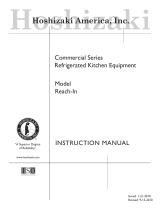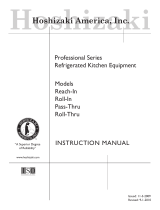
15
(3) Comp/ConFM/CRES EvapFM Diagnosis: Conrm Comp, ConFM, and EvapFM
de-energize. If not, check for 115VAC at CM C1 (BR or BK) to neutral(W).
If115VAC is present, replace CM.
(4) CPT EvapFM Diagnosis: Conrm EvapFM de-energizes. If not, check for
115VAC at CM F5 (DBU) to neutral (W). If 115VAC is present, replace CM.
2) Defrost-Termination: There is a 5 min. minimum defrost time and a 1 hr. maximum
defrost time. Has 5-min. minimum defrost timer terminated? Conrm DTh status.
See "II.C. Thermistor Check."
(1) CM, DTh, and DH Diagnosis: If5-min. minimum defrost timer has terminated,
has DTh warmed to 41°F (5°C)? If DTh has not warmed to 41°F(5°C), check
DST and DH continuity. Next, check DH amp draw. If DTh is in proper range,
DHde-energizes. Ifnot, replace CM. Once DH de-energizes, 1-min. Comp/
EvapFM delay timer and 11-min. temperature display delay timer start. Defrost
icon and "dEF" display continue. If not, replace CM. If41°F(5°C) is not achieved
within 1 hr., CM terminates defrost.
(2) Comp/ConFM/CRES EvapFM Diagnosis: 1-min. Comp/EvapFM delay timer
terminates. Comp icon turns on and Comp, ConFM, and CRES EvapFM
energize. If not, conrm CTh is warm enough for Comp, ConFM, and CRES
EvapFM operation. Next, check for 115VAC at CM C1(BR or BK) to neutral(W).
If115VAC is not present, check CTh status. "II.C.Thermistor Check." If CTh
ohm reading is in proper range, and Comp, ConFM, and CRES EvapFM do not
energize, replace CM. If 115VAC is present at CM C1(BR or BK), check that
CRES EvapFM energize. If not, check for loose wiring, fan blades binding, and
CRES EvapFM winding continuity. Relace as needed. Next, check for closed
HPS. If closed, check Comp start components, Comp external protector, and
Comp motor winding continuity. If ConFM is not energized, check ConFM fan
blades for binding and motor winding continuity.
(3) CPT EvapFM Diagnosis: 1-min. Comp/EvapFM delay timer terminates. If DTh
is at 36°F(2°C) or lower, EvapFM icon turns on and CPT EvapFM energizes.
Ifnot, conrm that DTh is at 36°F(2°C) or lower. If not, conrm Comp is on and
cooling. See "II.B.5)b) Comp/ConFM Diagnosis" and "II.C. Thermistor Check."
Once 36°F(2°C) or lower is achieved, check for 115VAC at CMF5 (DBU) to
neutral (W). If 115VAC is not present, replace CM. If 115VAC is present, and
CPT EvapFM is not energized, check CPT EvapFM blades for binding and CPT
EvapFM winding continuity.
(4) 11-min. temperature display delay timer terminates: "dEF" is replaced by
cabinet temperature on display. If not, replace CM.
Legend: CM–control module; Comp–compressor; ConFM–condenser fan motor;
CTh–cabinet thermistor; DH–defrost heater; DST–defrost safety thermostat;
DTh–defrost thermistor; EvapFM–evaporator fan motors; HPS–high-pressure
switch























